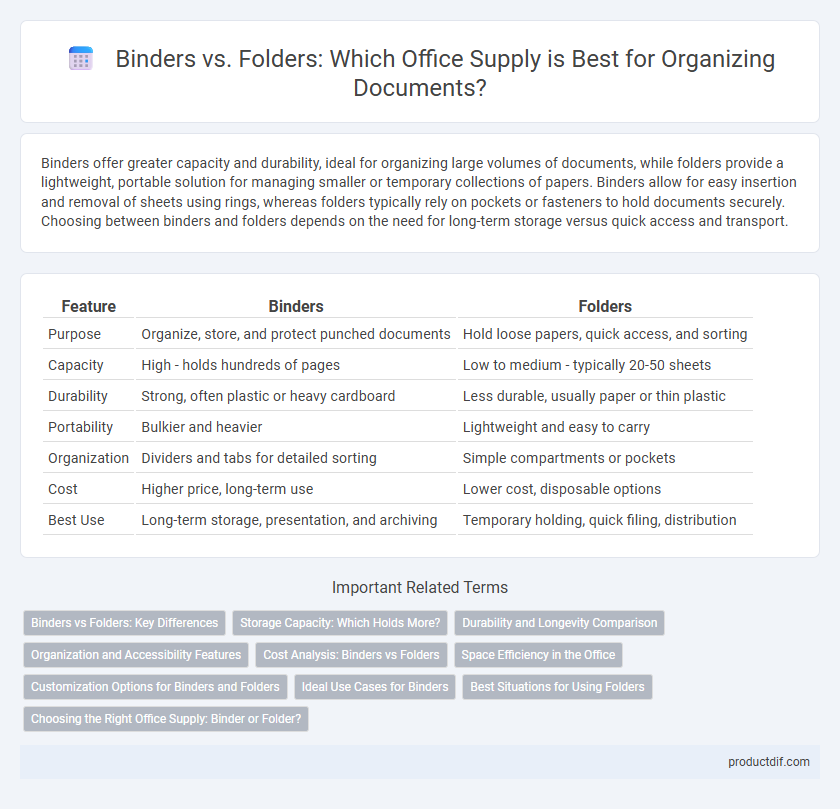Binders offer greater capacity and durability, ideal for organizing large volumes of documents, while folders provide a lightweight, portable solution for managing smaller or temporary collections of papers. Binders allow for easy insertion and removal of sheets using rings, whereas folders typically rely on pockets or fasteners to hold documents securely. Choosing between binders and folders depends on the need for long-term storage versus quick access and transport.
Table of Comparison
| Feature | Binders | Folders |
|---|---|---|
| Purpose | Organize, store, and protect punched documents | Hold loose papers, quick access, and sorting |
| Capacity | High - holds hundreds of pages | Low to medium - typically 20-50 sheets |
| Durability | Strong, often plastic or heavy cardboard | Less durable, usually paper or thin plastic |
| Portability | Bulkier and heavier | Lightweight and easy to carry |
| Organization | Dividers and tabs for detailed sorting | Simple compartments or pockets |
| Cost | Higher price, long-term use | Lower cost, disposable options |
| Best Use | Long-term storage, presentation, and archiving | Temporary holding, quick filing, distribution |
Binders vs Folders: Key Differences
Binders offer sturdy, reusable storage with ring mechanisms ideal for organizing punched documents, while folders provide lightweight, flexible options for temporarily holding loose papers. Binders typically support higher capacity and greater durability, making them suitable for long-term use and extensive file collections. Folders excel in portability and ease of access, best for sorting and transporting smaller sets of documents.
Storage Capacity: Which Holds More?
Binders typically offer greater storage capacity than folders, accommodating hundreds of pages with customizable rings that can expand up to three inches or more. Folders are designed for lighter storage, usually holding 20 to 50 sheets each, making them ideal for organizing smaller document sets. Choosing binders is more efficient for bulk storage and long-term organization, while folders serve well for simpler, temporary filing needs.
Durability and Longevity Comparison
Binders offer superior durability and longevity due to their rigid covers and reinforced rings that securely hold documents, making them ideal for heavy use and frequent access. Folders, typically made from lighter cardstock or plastic, provide less protection and tend to wear out faster with regular handling. Choosing binders over folders ensures greater document preservation and sustained organization in high-traffic office environments.
Organization and Accessibility Features
Binders offer customizable organization with removable and rearrangeable pages, making it easy to categorize and update documents. Folders provide quick access through simple pocket designs, ideal for sorting and transporting different files without bulk. Both enhance office efficiency by improving document accessibility and maintaining order in various work environments.
Cost Analysis: Binders vs Folders
Binders generally have a higher upfront cost compared to folders but offer greater durability and capacity for organizing large volumes of documents, potentially reducing long-term expenses. Folders cost less initially and are suitable for temporary document management but may require frequent replacement, increasing cumulative costs over time. Evaluating the balance between initial investment and lifespan helps businesses decide the most cost-effective option for office organization needs.
Space Efficiency in the Office
Binders offer superior space efficiency by allowing documents to be organized vertically with easy access, minimizing desk clutter. Folders, while lighter and more portable, tend to stack horizontally, consuming more surface area and often requiring additional storage solutions. Choosing binders can optimize office space by consolidating large volumes of paperwork into a compact, upright system.
Customization Options for Binders and Folders
Binders offer extensive customization options including interchangeable spine labels, cover inserts, and various ring sizes suitable for different document types. Folders can be personalized with printed logos, tab designs, and materials such as plastic or kraft paper to enhance branding and organization. Both binders and folders allow for tailored solutions, but binders provide more flexibility for adding, removing, or rearranging pages.
Ideal Use Cases for Binders
Binders are ideal for organizing large volumes of documents that require frequent updating or easy access, such as project reports, training materials, and reference manuals. Their durable construction and customizable spine labels make them perfect for long-term storage and systematic filing in office environments. Binders also accommodate tab dividers and sheet protectors, enhancing document organization and protection.
Best Situations for Using Folders
Folders are ideal for organizing loose papers and documents that require quick, easy access without bulk. They excel in short-term projects or meetings where portability and minimal storage capacity are prioritized. Folders are perfect for presentations, handouts, or temporary document sorting in office environments.
Choosing the Right Office Supply: Binder or Folder?
Binders offer robust organization with customizable inserts and secure ring closures, making them ideal for storing large volumes of documents or presentations. Folders provide lightweight, flexible storage with quick access, perfect for temporary use or transporting smaller document sets. Selecting between binders and folders depends on document volume, need for durability, and ease of access in your office workflow.
Binders vs Folders Infographic

 productdif.com
productdif.com